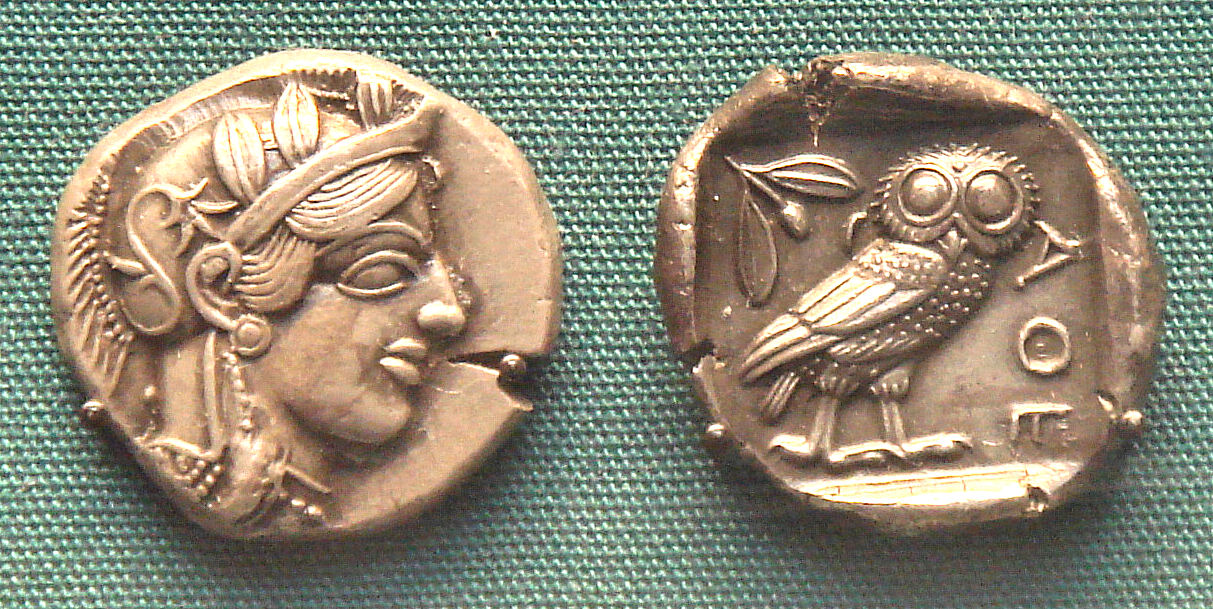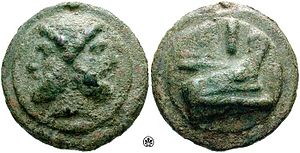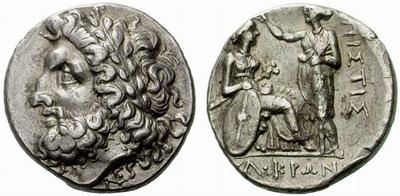After a (short) absence for exams, I am back, and with an old favourite of mine: King Cleomenes I of Sparta. You might not remember him from such films as 300, when he was the king who threw the envoys into the well, with the immortal line: "You'll find plenty [of earth and water] down there". Sorry Leonidas.
Parentage
First things first: the Spartans had two kings at any one time, descended from different lineages. For more information on that, see this
blog. Cleomenes was from the Agiad line, and was the eldest son of Anaxandrides II. But Anaxandrides had a bit of a problem.
You see, his wife (whose name is not recorded) seemed to be unable to conceive. They were (apparently) happy, but alas, there were no children. The Ephors (who weren't creepy inbred priests, but rather an elected council of officials) were worried about this: there were no heirs to the throne, and at this rate it didn't look like there would be. So what would they do? The only sensible thing, of course. They told Anaxandrides to take another wife. Well, he refused to divorce her (he loved her too much for that), so he just took a second wife. Seems to have worked out rather well for him there.
This new wife quickly got on with bearing a son: Cleomenes. Unfortunately (but somehow typically), the first wife miraculously became pregnant, and had Dorieus, Leonidas, Cleombrotus in quick succession. Spartan law was a bit shaky on these things, and so both Cleomenes and Dorieus had strong claims to the throne.
Despite the Ephors' preparations, succession was going to be a difficult time. In the event, three of the sons held power at one time or another.
Succession
While they were young, Cleomenes seemed to verge on madness, and Dorieus was the darling of everyone. Dorieus was sure he would be made king, as he was so clearly suited for the job. Unfortunately, that's never really counted for much when appointing new kings, and he was passed over in favour of Cleomenes. Deciding he couldn't bear it, Dorieus asked to be given a group of men and set out to found a colony, though quite how he intended to do that with only men in his group he never explained. In the event, he flounced off in a fit of pique and bummed around the Mediterranean for a bit without any real goal in mind (no change there for sons of the aristocracy). Later he upset the Oracle, and probably died in a foreign war. Cleomenes seemed secure.
Wars at Athens
Cleomenes was later involved in several excursions outside the Peloponnese, most notably to Athens. This may partly explain why he was considered so reckless by the other Spartans: Spartan forces rarely left the Peloponnese in case of a Helot revolt in their absence. Sparta held hegemony over most of the Peloponnese at this point, and it could be easily defended at the Isthmus of Corinth. See the map below.
Cleomenes first went to Athens after receiving an oracle that instructed him to remove the tyrant Hippias from the city. He duly did so. Two Athenian statesmen then fought each other for the right to rule Athens, and Cleomenes attempted to interfere on the part of one of them, but his Corinthian allies mutinied. This second expedition was abandoned, and everyone went home.
However, some time soon after Cleomenes decided he should
restore Hippias to Athens. This is a U turn of which even the grubbiest politician could be proud, but it did have some basis: it turned out that the Athenians had bribed the oracle to instruct Cleomenes in the first place. Wheels within wheels.
However, once again the allies mutinied, this time in the first act of the Peloponnesian League (who become important later in the Peloponnesian War), and the plan was abandoned.
The Ionian Revolt, or What Cleomenes Did Next
Cleomenes was later asked for help by Aristagoras. He was from Miletus which was on other side of the Aegean (see map), and wanted help for his revolt against the Persians. This revolt is credited by Herodotus as being the start of the Graeco-Persian Wars. His suit was unsuccessful. The king could not take Spartan troops on a three month journey from the city; the danger of revolt was too great. Aristagoras pursued him for several days, offering larger and larger bribes until Cleomenes young daughter Gorgo (yes, that makes Leonidas her half-uncle, yes, she's the attractive lady from 300) overheard them. With all the self assurance of an eight or nine year old, she said: "Father get up and go, or the stranger will certainly corrupt you". Cleomenes was supposedly swayed by this, and went out of the room.
The Athenians would later offer aid to Aristagoras, and (again, according to Herodotus) "These ships were the beginnings of [all] the evils". Supposedly, the Persians would have left main Greece alone, but for this aid.
Dethroning Demaratus
Demaratus was Cleomenes' co-king for much of his reign. He took the Corinthians' side in many of the mutinies, and was generally unhelpful. After the failure of the Ionian Revolt, many of the smaller cities surrendered to Persian, including Aegina. Cleomenes decided to make an example of them, and demanded the handing over of the collaborators. They refused, Demaratus swanned around undermining his authority, and really, there was only one option open to him now.
So, Cleomenes sent a bribe to the Oracle (after all, it had worked out really well for the Athenians), and had her find for Leotcyhides, a relative of Demaratus. The reason? Demaratus' parentage was in dispute. Seems a bit rich, coming from Cleomenes.
However, the Spartans, pious as ever, duly got rid of Demaratus and appointed Leotychides. Demaratus was forced to flee to Persia, where he advised King Xerxes about Spartan tactic (you may remember him from The 300 Spartans). Leotychides was later condemned for taking Persian bribes. It's hard to know who got the raw end of the deal here.
Madness and Death
As with all good stories, Cleomenes' plot against Demaratus was discovered, and he was forced to leave Sparta in exile. He travelled for a time, notably learning to drink his wine neat (as the Scythians and other barbarians did), rather than dilute (which all abstemious Greeks did). The Spartans later claimed this was a contributing factor to his madness. Cleomenes then tried to gather armies for a revolt against Sparta from her allies.
The Spartans brought him back to their city, where he was afflicted with a strange madness: which apparently compelled him to strike every Spartan he
met upon the face with his sceptre. His surviving half-brothers claimed he was completely insane and placed him in prison. He was supposedly left alone in stocks, with a single Helot guard. He frightened this man into handing over a knife and proceeded to mutilate himself to death. This was the story put about by Leoniadas, who now assumed the throne.
It is not improbable that reports of his madness had been exaggerated, and that Leonidas had him quietly removed- probably by a member of the Krypteia.
Footnotes, Endnotes and Appendices: Cleomenes was king for about 30 years (c. 520- 489). While most of what we hear about him is amusingly bad press, he was probably a very competant general and a seemingly brilliant tactition. Few other Spartan generals have such a record of success (sorry Leonidas).
Oh, and Cleombrotus gained power after Leonidas' death, when he acted as Regent for Leonidas' young son by Gorgo.




